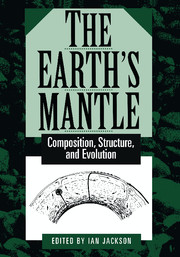Book contents
- Frontmatter
- Contents
- Chapter Outlines
- Contributors
- Dedication
- Preface
- I Accretion and Differentiation of the Earth
- 1 Composition of the Silicate Earth: Implications for Accretion and Core Formation
- 2 Early Differentiation of the Earth: An Isotopic Perspective
- 3 Primordial Solar Noble-Gas Component in the Earth: Consequences for the Origin and Evolution of the Earth and Its Atmosphere
- II Dynamics and Evolution of the Earth's Mantle
- III Structure and Mechanical Behaviour of the Modern Mantle
- Index
1 - Composition of the Silicate Earth: Implications for Accretion and Core Formation
Published online by Cambridge University Press: 23 November 2009
- Frontmatter
- Contents
- Chapter Outlines
- Contributors
- Dedication
- Preface
- I Accretion and Differentiation of the Earth
- 1 Composition of the Silicate Earth: Implications for Accretion and Core Formation
- 2 Early Differentiation of the Earth: An Isotopic Perspective
- 3 Primordial Solar Noble-Gas Component in the Earth: Consequences for the Origin and Evolution of the Earth and Its Atmosphere
- II Dynamics and Evolution of the Earth's Mantle
- III Structure and Mechanical Behaviour of the Modern Mantle
- Index
Summary
Our knowledge of the constitution and composition of the Earth's mantle has advanced enormously during the last 30 years… As a result of these developments many new and important boundary conditions for the origin of the Earth have emerged. I do not believe that the significance of these boundary conditions, mainly of a geochemical nature, [has] been adequately recognised in many recent discussions of the origins of terrestrial planets in general and of the Earth in particular.
— A. E. Ringwood (1979)Introduction
The formation of our solar system followed the collapse and fragmentation of a dense interstellar molecular cloud. As interstellar matter always has some angular momentum, the development of a central star by direct infall was not possible, and instead a rotating disk resulted. Material within the disk lost angular momentum through viscous dissipation or other processes, leading ultimately to the growth of a central star, our Sun. Only a tiny fraction of the mass of the solar system (∼0.1%) was left behind in the disk, eventually to form the planets and asteroids.
The duration of the initial collapse phase was short, less than 1 million years. After this phase, the remnants of the accretion disk may have persisted for as long as 10 million years before the planets were assembled. This history derives from astronomical observations and is consistent with isotopic evidence from meteorites (Podosek and Cassen, 1994). The mixture of gas and grains that made up the proto-solar accretion disk is known as the solar nebula.
- Type
- Chapter
- Information
- The Earth's MantleComposition, Structure, and Evolution, pp. 3 - 126Publisher: Cambridge University PressPrint publication year: 1998
- 13
- Cited by



